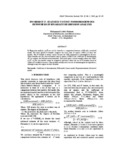| dc.contributor.author | Rahman, Mohammad Lutfur | |
| dc.date.accessioned | 2010-10-18T05:46:07Z | |
| dc.date.available | 2010-10-18T05:46:07Z | |
| dc.date.issued | 2005 | |
| dc.identifier.uri | http://hdl.handle.net/10361/540 | |
| dc.description.abstract | In Regression analysis, an F test can be viewed as a comparison between a full and a restricted
model. The most general F formula compares the error sums of squares (SSE’s) of these two
models. This F formula is always correct because the SSE comparison is meaningful in all tests. Other formulas use the corrected model sum of squares (SSM) or the coefficient of determination (R2) to compare the full and restricted models. This article gives several examples where the SSM’s
or R2’s of the two models cannot be compared, and hence where the use of F formulas based on SSM or R2 would be incorrect. This problem usually arises in tests of nonhomogeneous hypotheses, although it may also appear in other situation. | en_US |
| dc.language.iso | en | en_US |
| dc.publisher | BRAC University | en_US |
| dc.relation.ispartofseries | BRAC University Journal, BRAC University;Vol.2, No.2,pp. 35-38 | |
| dc.subject | Coefficient of determination | en_US |
| dc.subject | Full model | en_US |
| dc.subject | Linear model | en_US |
| dc.subject | Reparametrization | en_US |
| dc.subject | Restricted model. | en_US |
| dc.title | Incorrect F-statistic to test nonhomogeneous hypothesis in bivariate regression analysis | en_US |
| dc.type | Article | en_US |

